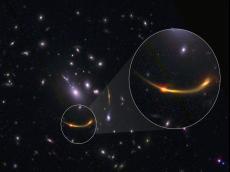|
|
TODAY.AZ / World news
Astronomers discovered a new disk galaxy orbiting far from Earth
08 October 2024 [20:21] - TODAY.AZ

By Alimat Aliyeva
Astronomers have discovered the oldest known example of disk galaxies orbiting far from Earth, in the constellation Sextant. They noted that this galaxy will be observable only 700 million years after the Big Bang, Azernews reports.
The discovery of an ancient disk galaxy rotating like the Milky Way casts doubt on the theory of the speed of transformation of the chaotically arranged primordial Universe into strictly ordered galaxies filling space in the modern historical period.
Disk galaxies are among the most common objects in the universe, accounting for about 60 percent of the total number of galaxies, said Lucy Rowland, an astronomer at the University of Leeds. This category includes both spiral and lenticular galaxies. The shape of a disk galaxy resembles a flat disk of tens or hundreds of billions of stars. This range includes the Milky Way and its nearest large neighbors.
Astronomers previously believed that such galaxies did not exist in significant numbers in the early universe, because they believed that the high frequency of galaxy mergers and the increased activity of supermassive black holes prevented ancient galaxies such as the Milky Way and its analogues from acquiring an ordered structure. a structure characteristic of the universe. Rowland proved this idea wrong by observing the early universe with the ALMA microwave telescope.
As the scientists noted, this telescope is able to see the movement of the coldest gas and dust streams, and recently astronomers used a ground-based survey telescope to determine the structure of the ancient galaxy REBELS-25, discovered in the constellation Sextant. ALMA observations have shown that this object is not a chaotic elliptical galaxy typical of the early universe, but is a large disk galaxy with a mass of about 10 billion times that of the sun.
According to astronomers, this figure is only a small sample of the mass of the Milky Way, which indicates the presence of large disk galaxies in the early Universe, very similar to ours. This discovery indicates the incompleteness of existing theories of the evolution of galaxies. Scientists have concluded that large spiral and lenticular galaxies began to form later, when the universe was in a less chaotic state and calmed down.
URL: http://www.today.az/news/regions/253845.html
 Print version
Print version
Connect with us. Get latest news and updates.
See Also
- 05 December 2025 [23:23]
Kia celebrates 80th with new concept car - 05 December 2025 [22:49]
Certain citizens may face US entry limits - 05 December 2025 [21:42]
France targets Shein with temporary block - 05 December 2025 [20:50]
China launches longest nonstop flight - 05 December 2025 [09:00]
Teen social media accounts block in Australia - 05 December 2025 [08:00]
Android adds feature to mark urgent calls - 04 December 2025 [23:50]
Georgia bans foreign students in public universities - 04 December 2025 [23:23]
Ankara to deploy voice-guided AEDs across public spaces under 2026 regulation - 04 December 2025 [22:23]
Kahramanmara? reconstruction accelerates with 52,000 homes delivered - 04 December 2025 [21:22]
Turkiye, Pakistan sign major hydrocarbon deals in landmark energy cooperation
Most Popular
 European Union is once again promising Armenia what it cannot fulfill
European Union is once again promising Armenia what it cannot fulfill
 Pashinyan showed the wrong side of the Karabakh negotiations: there is no sensation for us, it is a shock for the Armenians
Pashinyan showed the wrong side of the Karabakh negotiations: there is no sensation for us, it is a shock for the Armenians
 Turkiye, Pakistan sign major hydrocarbon deals in landmark energy cooperation
Turkiye, Pakistan sign major hydrocarbon deals in landmark energy cooperation
 Yerevan’s narrative on detainees masks domestic politics [OPINION]
Yerevan’s narrative on detainees masks domestic politics [OPINION]
 Residents of orphanage visit Academic Musical Theater as guests
Residents of orphanage visit Academic Musical Theater as guests
 Baku to host 16th International Film Festival
Baku to host 16th International Film Festival
 Ankara to deploy voice-guided AEDs across public spaces under 2026 regulation
Ankara to deploy voice-guided AEDs across public spaces under 2026 regulation
